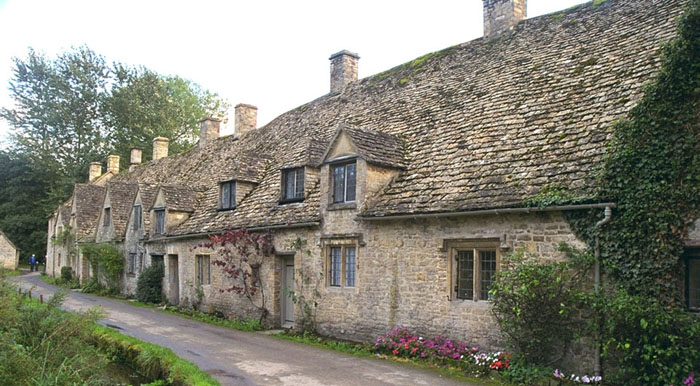 Some of the most historically important building stones come from a group of limestone layers deposited during the latter part of the Jurassic period (145 – 200 million years ago) in what is now central England. These Jurassic limestones crop out in a narrow swath from the English Channel northeastward to the North Sea. They range from softer honey-colored limestones in the Cotswolds to the harder gray Portland limestone on the south coast.
Some of the most historically important building stones come from a group of limestone layers deposited during the latter part of the Jurassic period (145 – 200 million years ago) in what is now central England. These Jurassic limestones crop out in a narrow swath from the English Channel northeastward to the North Sea. They range from softer honey-colored limestones in the Cotswolds to the harder gray Portland limestone on the south coast.
The Cotswolds are a beautiful region of rolling hills where honey-colored Jurassic limestones have been quarried and used as building stone for millenia. From the 1200’s through the 1800’s, Cotswolds merchants became weathly in the wool trade for which this region was famous. This wealth built the quintessentially English stone villages in the Cotswolds.
During the Roman occupation of Britain in the first century A.D., these same Jurassic limestones, quarried near Bath, England, were used to build the famous Roman baths and temples around a warm spring that was thought to provide health benefits. They were also used to build churches, abbeys and countless other structures in the World Heritage City of Bath.
Portland Stone is another Jurassic limestone quarried on the Isle of Portland in Dorset on the English Channel. It is light gray and harder than the honey-colored Jurassic limestones to the north. Portland Stone is considered a “freestone,” meaning it can be worked in all directions. This property makes it an excellent building material. Portland Stone has been used throughout the British Isles and the world, including in Buckingham Palace and St. Paul’s Cathedral in London and in the United Nations building in New York.
Photos from top: Outcrop area of Jurassic limestones in England; Limestone house in Chipping Campden in the Cotswolds; Roman baths built from Jurassic limestones in Bath, England; Buckingham Palace in London, built from Portland limestone.

